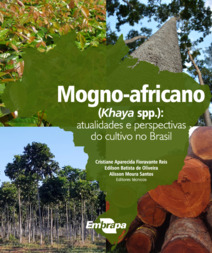African mahogany: book highlights significant growth of this species in Brazil along with production and prospects
African mahogany: book highlights significant growth of this species in Brazil along with production and prospects
During the 25th World Congress of the International Union of Forest Research Organizations (IUFRO), Embrapa Florestas launched Mogno-africano – atualidades e perspectivas do cultivo no Brasil [African mahogany: news and prospects for cultivation in Brazil]. The team behind the book included researchers Cristiane Fioravante Reis, Edilson Batista de Oliveira, Alisson Moura Santos.
The text is meant for companies, forest producers, technicians, students, and institutions, and aims to summarize and provide important information on African mahogany because of the growth of plantations of this species in Brazil as well as its economic potential, in order to guide crop planning and decision-making.
According to Edson Tadeu Iede, head of Embrapa Florestas, native African mahogany has been internationally recognized for its various applications, which include luxury furniture, ornaments, wooden inlays, musical instruments, laminates, cutlery, home and boat construction, and internal and decorative finishes. Iede stated that cultivation of this species has grown significantly in recent years, estimated at over 37,000 hectares in 2018, making the country the largest grower of this genus, followed by Australia with 14,000 hectares.
"The main reasons behind investments in African mahogany plantations in tropical areas worldwide are its wood, which has mechanical and physical properties, appearance and workability similar to Brazilian mahogany, rapid growth, established uses for this wood with high prices on the international market (as long as it is harvested at an appropriate age, with a high percentage of heartwood and adequate processing), considerable reduction of native tree individuals and/or bans on cutting mahogany, whether Brazilian or African," he added.
To whet the curiosity of readers, the authors highlighted the various topics addressed in the book, such as a description of relevant species in the genus Khaya in Brazil, uses and economic importance of timber and non-timber products and their market prospects, legal aspects of African mahogany plantations on agricultural properties, public policies related to cultivation of the species, Brazilian soil and climate zones, aspects of forestry when this species is used solid stands as well as in integrated crop-livestock-forest systems, growth and production of African mahogany wood in several regions of Brazil, diseases and insects capable of economic damage, software for precision management and economic analysis of African mahogany in solid stands as well as integrated systems, technical characteristics of the wood, and the importance of certification in commercial plantations.
"The book takes a broad approach, ranging from the choice of species to selling the final product. This range of detailed information will certainly help develop the production chain for African mahogany globally and particularly here in Brazil, which strengthens the forestry sector as a whole," he said.
The book "Mogno-africano – atualidades e perspectivas do cultivo no Brasil" is available to download for free at Embrapa’s website.
Pre-releases
Embrapa Florestas took advantage of the presence of researchers from all over the world at the IUFRO Congress to pre-launch two other publications: “O eucalipto e a Embrapa: 40 anos de pesquisa e desenvolvimento” [Eucalyptus and Embrapa: 40 years of research and development] and “Araucária: pesquisa e desenvolvimento no sistema cooperativo e integrado da Embrapa” [Araucaria: research and development in Embrapa’s cooperative and integrated system].
The book about eucalyptus is edited by researchers Edilson Batista de Oliveira and José Elidney Pinto Júnior and describes 40 years of Embrapa Florestas's efforts to construct and supply knowledge about the use of eucalyptus and Corymbia species in commercial and environmental plantations, as well as the social benefits they provide.
The other text brings together the various fronts of basic and applied research on Araucaria trees, with technical information about the species such as its genetic, ecological, anatomical, and physiological aspects.
According to Jarbas Yukio Shimizu, one of the authors, the level of knowledge gained over the years represents a valuable tool in efforts to remove Araucaria species from the endangered list, helping it to return to its former position as a showcased product from forest economics and social and economic development in rural areas.
Maureen Bertol (MTb8330 PR)
Embrapa Florestas
Press inquiries
florestas.imprensa@embrapa.br
Phone number: 66 99232-1901
Further information on the topic
Citizen Attention Service (SAC)
www.embrapa.br/contact-us/sac/


